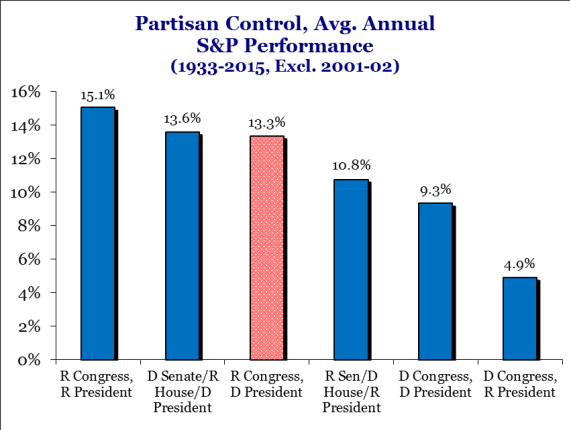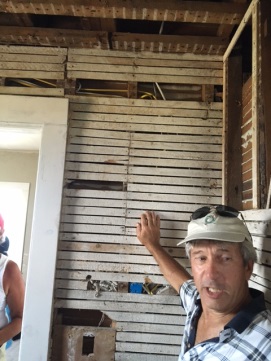Sean C. Kelly, CFA®, CFP®, CIMA®
Senior Vice President, Wealth Management
Managing Director
Lifestyle, community, and market insights from your St Pete Wealth Management team
Elections and Investments
Good morning friends.
In a matter of days we will have a new president elect. Let’s agree that many in the country will be elated, many will be disappointed and many will be indifferent. The good news, I suspect, is that most of us will also be relieved that the election is in the rearview mirror. All elections cycles tend to stir up passion and often can get mired in negative news cycles to the detriment of real issues that directly affect our lives. The history books will show that the election of 2016 was absolutely no exception.
While we are not swamped with calls from concerned clients, we are getting the occasional question and request for a defensive posture in case of a Clinton/Trump victory on Election Day. And yes, those calls are coming in from both sides of the isle. We have always made it a point to stay non-partisan at the St Pete Wealth Group. We are essentially split down the middle in terms of our viewpoints and have representative opinions from all walks of life. We always see our job as stewards of our client’s wealth and that requires us to exist more as umpires calling balls and strikes than actually being a participant in the game. This is a position that we are very comfortable with and in this election, as you can imagine, we can find pros and cons with regard to proposed policy from both parties.
It is with this in mind that we wanted to propose an alternative viewpoint to many who are contemplating whether this is a do or die election with regard to your investments. To be clear, there are policy decisions regarding tax, healthcare, entitlements, etc. on the ballot that will likely touch your wallet. However, the impact of this election on the direction of capital markets over the long term is more predictable and less impactful than you probably think. Let us explain.
In the research attached by Federated and Strategas from April of 2016, we see average annual performance of the S&P500 under various party controls of the Presidency and Congress. For example, in years from 1933-2015 when you have had democratic President and a republican Congress (seen in red) the S&P has grown by an average of 13.3%. You can simply read the rest of the chart to see historical results under other configurations of partisan control. Keeping in mind that timing of events such as recessions, world wars, geopolitics and leaps in technology (to name a few) play a role in those results is encouraged.

In our opinion, the difference in historical performance dependent on party control is not the most interesting part of this study. The highlight is the worst historical configuration of republican President and democratic Congressional control still yielded a positive 4.9%. A number unlikely to occur by investing in cash or fixed income over the next 4 years. This R/D configuration occurred in 11 years in that sample (3 Eisenhower, 3 Nixon, 1 Nixon/Ford, 1 Ford, 1 Reagan, 2 Bush Sr, 1 Bush.) As you can see, the 2nd worst configuration was 9.3% and so on and so forth.
The take away, as an investor, should be that stocks in particular discount prices as a result of economic growth, innovation, entrepreneurship, velocity of capital (confidence) and many more nonpolitically related inputs. Presidents come and go but growth in capital markets and investment accounts on average have sustained and thrived under every single political party control. Consider also that these sample periods include world wars, global recessions, terrorism and worse. As investment managers, we are more concerned world population growth, capital becoming more readily available to developing countries and technological innovation than we are with political parties. The intention here is not to foolishly diminish politics all together but to highlight that stock returns and political parties have a lower correlation than most would think and therefore, in our opinion, do not warrant a wholesale change in strategy dependant upon the victor.
With that said, there are two caveats to this very important call for patience. First, we actually do expect a continuation of the short term volatility we have experienced the past few months to continue in the near term. Uncertainty is the foundation of risk and right now we have uncertainty both in the result but also in policy being discussed from both sides. This is the second and more important point. While markets tend to ignore party politics, they do not ignore long term economic growth trends and thus, we are on the lookout for trending policy decisions that could slow or accelerate economic growth. As always, we will act accordingly if we believe the odds of an elongated negative investing environment become more likely. However, our base case for near term volatility with a long term positive outlook remains intact.
We hope this gives you some confidence in the future of stocks regardless of who enters the White House. Of course, if you remain uneasy about your current strategy, please do not hesitate to contact us and we can walk you through options. Until then, we hope you are having a wonderful start to the fall season.
Views expressed are those of Raymond James & Associates and are subject to change without notice. Information provided is general in nature, and is not a complete statement of all information necessary for making an investment decision, and is not a recommendation or a solicitation to buy or sell any security. Past performance is not indicative of future results. There is no assurance these trends will continue or that forecasts mentioned will occur. Investing always involves risk and you may incur a profit or loss. No investment strategy can guarantee success.
Building a Memory and a Dream
September 12th, 2016
Marcia F. Person, CDFA™
Senior Vice President, Investments

We all have memories from our childhood that elicit a warm feeling when we think about them. For some of us it’s a passing thought that brings a smile to our faces, but for others it lingers in our minds. For a client (who I shall call Jane), the happy memory of boat rides with her family to a small island with a lighthouse off the coast of Maine was the inspiration for a gift that would change the future of a historic landmark.
During an annual visit to a 4th generation family vacation home, Jane decided to take a tour of the aging lighthouse from her childhood to see its current condition. Much to her surprise she found that a major restoration project was underway. Jane was impressed with how hard the group was working and what they had been able to accomplish with such limited funds. She penned a letter to a committee working on the project to better understand the scope of the work and what would be required to complete it. Regarding that letter Jane said, “My longtime interest in historic preservation and my fascination with Wood Island Lighthouse from my many summers at our family home in Saco, prompted me to write.”

Following two more trips back to the island and some communication with the folks at FOWIL (Friends of Wood Island Lighthouse), Jane knew that her financial commitment could help secure the future of the Wood Island Lighthouse. She wanted to ensure that generations to come could begin making their memories there. After corresponding with Brad Coupe, the Chair of FOWIL’s Executive Committee, Jane learned of the magnitude of the project. This only served to bolster her commitment to helping to save this New England treasure. She learned that she could help them complete the restoration, and as an additional benefit, funds could be diverted from the refurbishment to other important work.

So how does one go about making significant, systematic donations to a charitable organization in a judicious and well-orchestrated way? Budgeting can be a challenge for a small organization as they do not regularly receive large donations like larger organizations do, and we want our charitable gifts to be used prudently.
Most often clients make charitable contributions simply by writing checks and taking the appropriate deductions at tax filing time. However, as part of an overall estate planning strategy we devised, Jane established a Raymond James Charitable Donor Advised Fund a few years ago utilizing low cost basis stock. (Of course funding with cash is also fine.) Raymond James Charitable makes grants to charitable organizations on behalf of the client so that they can enjoy the power of giving without the hassle of timing, tax concerns, expenses and record-keeping. Because Raymond James Charitable is a tax-qualified public charity, Jane received an immediate and full tax deduction while the funds had the potential to grow over time.
There are several other vehicles available to create gifting strategies during one’s lifetime or after their passing. The Donor Advised Fund worked well for our purposes and continues to be available for other grants Jane may wish to make in the future.
Working directly with the committee from FOWIL in charge of the restoration, we were able to submit requests for grants to coincide with each phase of the construction. Once the organization was verified by Raymond James Charitable, the funds were sent directly to the 501(c)(3) for their use.
On August 20th, I had the overwhelming privilege and pleasure of accompanying Jane and her husband as she was awarded the American Lighthouse Foundation’s (ALF) “Keeper of the Light” award for “helping to preserve American’s lighthouses and their rich heritage”. Following the presentation we were treated to a boat trip out to the 35 acre island to tour the property, the keeper’s house, and the lighthouse itself.
The original Wood Island lighthouse was built in 1808 and constructed of wood, but the current lighthouse which replaced it was erected in 1839. Standing 47 feet high, I braved the steps to the top as they narrowed to the remaining wrought iron steps barely wide enough for my size 6 feet. Perched on that narrow platform surveying the Atlantic Ocean in the distance, I had a brief glimpse into what the life of a lighthouse keeper might have been like in the harsh winters of Maine in 1839. After a glorious lobster roll picnic on the porch, we reluctantly boarded the boat for our journey back to the future.





We all have the ability to help build a dream and a memory for someone’s future. Whether telling tales of your youth to your children and grandchildren or contributing to an organization to see it sustain and thrive, these are the building blocks that help enrich the future for generations to come.
If you would like more information on charitable gifting strategies, please feel free to email or call us.
Back to School
August 12th, 2016
Ross D. Preville, WMS
Senior Vice President, Investments
As summer vacation from school comes to an end, my wife and I will soon be fighting the battle of getting the kids up in the morning. This fracas is a daily ritual in our house during the school year as one enters high school and the other one continues in middle school. Fortunately, we have learned the system of divide and conquer to get it accomplished. As I reflect back over the summer, I’m amazed at what a 14 year old’s life looks like in 2016. I commented to a friend recently that when I was our son’s age, my summers were spent running around the streets of St Pete - no organized programs - just having fun. It illustrates how much more sophisticated our kids have become and just how competitive the educational landscape is.
During his school break this year, our son headed off to Duke TIP Camp (Duke University Talent Identification Program) just outside of Dallas where he took a three week course on Engineering Design Flaws. Founded in 1980, Duke TIP’s mission is to find “academically talented students” and give them an outlet to take their education to another level. It was an eye opening experience for our teenager to be independent (within reason) and to take responsibility for himself in an environment where his parents were not there to push him. Last year’s curriculum was Physics and Design at Rollins College in Winter Park. He came home a different kid after that time away.
Today the post high school educational path often starts very early. This year, when my wife flew with our son to Dallas for the Duke program, she decided to go early to tour Southern Methodist University (SMU). Even though our son was just entering 9th grade, they were happy to schedule an appointment for them to meet with an academic advisor. While in Nashville two years ago, they spent a day visiting the campus of Vanderbilt.
Going to college is not optional according to my wife. This is certainly an opinion shared by many of our readers. That edict comes with its own set of responsibilities for the parents and/or grandparents. We feel that it requires our commitment to pay for that higher education, but we present it as a team effort. We are pledged to do our part, but we clearly set out their duties as well. Our expectation of our kids is that they do the work required to achieve the grades that will afford them the opportunity to apply for scholarships.
In addition, we are planning ahead for the costs not covered by scholarships by establishing 529 College Savings Plans for them. These plans are similar to a 401(K) plan in that they offer a menu of investments from which to choose. There are no income restrictions for those funding these accounts and one of the many other benefits includes their tax deferred growth. The tax free withdrawals for qualified educational expenses are another great reason to fund your 529 early and often. (It makes a great birthday gift from Grandma too!)
According to College Board, the average cost of tuition and fees for the 2015-16 school year was $9,410 for in-state public universities, $23,893 for out of state public universities, and $32,405 for private universities. Since our son had visited the campuses, I checked the websites of Vanderbilt and SMU. Their tuitions this year are $64,654 and $67,284 respectively. (Gulp)
It is never too early to plan for life’s biggest financial goals, and based on the cost of tuition today, a college education could be one of them. At St. Pete Wealth, we utilize software called Goal Planning and Monitoring (GPM) to help our clients plan for the future. Whether it’s college planning, retirement, a vacation house, or a bigger boat; this state of the art program assists us in preparing a plan for achieving those goals. I tell our clients to “dream big” when they come in for their initial meeting utilizing GPM, and together we will see what’s possible.
Please feel free to reach out to us if you want to work on those dreams and evaluate the possibilities for making them a reality. Best of luck this school year.
Brexit: A lesson in patience
July 6th, 2016
Sean C. Kelly, CFA®, CFP®, CIMA®
Senior Vice President, Investments
The whipsaw of almost all capital markets post the Brexit vote was incredible. We saw two days of market carnage followed by 4 straight days of rebounding markets worldwide. Economists, influential business leaders, and politicians alike were fighting for space on your computer and TV screens to tell you how awful or how wonderful the decision was. At the end of the week, most of us in the investment community were left scratching our heads a bit at the V-shaped recovery we had just experienced. Candidly, it seemed likely that this would play out over weeks or months, not days. This is not to say that the market implications surrounding these events are over. In fact they are likely just beginning as geopolitical uncertainties have been inserted into an already volatile international investment landscape. That said, the first inning of Brexit is in the books, and I thought it a prudent time to discuss what we all just witnessed and hopefully learned.
First and foremost, we were reminded that markets don’t like surprises. There is a saying we use quite often in the office. “It’s not the train I see coming that worries me.” Our money management process involves planning for events in which we assign probabilities to the likely outcomes and we invest accordingly. This is not an uncommon practice and certainly not exclusive to the investment world. Every once in a while, however, a train sneaks up on you from behind. Nassim Nicholas Taleb has written a series of books about uncertainty and randomness in which he uses the term “black swan” to essentially make the same point. This is a phrase you have probably heard before. Technically, statisticians refer to this as Kurtosis risk or tail risk, but “black swan” has a more appealing sound. According to Wikipedia, it’s a metaphor that describes an event that comes as a surprise, has a major effect, and is often inappropriately rationalized after the fact with the benefit of hindsight. So by that definition, was Brexit a black swan event? It was a bit of a surprise, and it did have a short term major effect (with the long term prognosis yet to be determined). In addition, you probably heard at least one person say, “I saw this coming.” So sure, by that definition it was - so what?
The stigma of black swan events is that they are all considered to be earth shattering events like the 2008 financial crisis or Black Monday in 1987. The danger for many investors is their hypersensitivity to these events since the great recession does not seem that long ago (Even though the market bottom occurred over 6 years ago.) Those constantly on the lookout for the next catastrophe are likely to misdiagnose many events as having more destructive power than they actually do. If that fear generates rash investment decisions then real damage is done to their long term financial well-being, and that is a shame. There were likely a number of investors scared out of their retirement investment strategy on Friday after the Brexit vote only to see markets roar higher by the next week’s end.
The lesson here, in my opinion, is that being aware of world affairs and how they are likely to affect your wealth is a good thing. However, making snap investment decisions because you are always waiting for the next shoe to drop is an exercise in futility. Sometimes patience is the best medicine for uncertainty. Regardless of the countless talking heads in the media speaking in absolutes within minutes of the vote, uncertainty is exactly what we have in the wake of this event. Only time will tell if Brexit becomes another overlooked black swan blip on a long term chart or something more. We will, as usual, stay glued to the situation, the implications as details emerge and will update where appropriate. We hope everyone had a wonderful holiday weekend!
Views expressed are those of The St. Pete Wealth Management Group and not necessarily those of Raymond James & Associates and are subject to change without notice. Information provided is general in nature, and is not a complete statement of all information necessary for making an investment decision, and is not a recommendation or a solicitation to buy or sell any security. Past performance is not indicative of future results. There is no assurance these trends will continue or that forecasts mentioned will occur. Investing always involves risk and you may incur a profit or loss. No investment strategy can guarantee success.
Thoughts on Brexit
June 26th, 2016
The St. Pete Wealth Management Group
Good morning friends,
As the saying goes, may you live in interesting times. It appears this morning, at least for now, we have just that with the overnight vote in the affirmative for the United Kingdom to initiate leaving the European Union. Polls going into yesterday’s event had the leave and remain voting blocs basically in a dead heat which would insinuate that no one should be surprised over the final tally. Although as of this morning, surprise is exactly what we have with worldwide currency, equity and bond markets repricing. The major reason for the volatility, aside from the long term consequences of this decision, is that over the past months global strategists, economists and columnists alike were handicapping the decision to a much heavier probability of UK remaining in the EU. The common wisdom is that the UK, England in particular would be so financially damaged in the aftermath of an exit that there is no way that a rational nation could inflict that upon themselves. Influential leaders such as Christine Lagarde at the IMF, British Prime Minister David Cameron (who resigned this morning), our own President Obama, et al. flexed the unified weight of their respective institutions in pleading and threatening to the UK citizens in an attempt to quell the unrest. All this for naught, of course as the result of last night’s vote seemed to regard trade, immigration and sovereignty policy issues at a premium to short term economic consequences.
Our interpretation of Brexit, first and foremost, is that this move does not mark the end of days. This is, however, a significant geopolitical event that will have ripples across investments, countries, companies and politics. As investors it is important to remember that ripples are not always bad and often times create opportunities. It is with this in mind that we have detailed a couple of bullet points below to consider in the initial stages of this event.
1. The UK leave vote has true policy implications that will begin to take shape a couple of years from now, not today. This is the core argument for our base case of global volatility being heightened in the short term but receding to more appropriate levels in the coming months.
2. One of the great advantages of EU membership is trade policy between nations. Through leaving the Union, they will renegotiate trade deals with member nations that may be more or less favorable than the current status quo. Britain runs a large trade deficit with greater Europe, meaning they buy more products and services from European countries than they sell. This infers that the UK will have leverage in negotiating the terms of its restructured deals although there will likely be some counterbalance by EU’s need to issue a penalty for trading with a nonmember.
3. The UK always maintained its status as a semi-detached member of the EU by its reluctance to adopt the EURO. Dissimilar from nations like France for instance, the UK never relinquished it national currency.
4. From an economic standpoint, the common wisdom is that the UK has the most to lose as a result of Brexit. By isolating their economy further, economists suggest that they will experience recessionary pressures. Meanwhile, it remains unclear what the economic implications are for the EU. The greatest and most damaging result would be if the UK exit is not an anomaly, and instead sparks a trend of future nations leaving the EU.
5. Even with this morning’s snap downside volatility, US equity markets are trading higher than they were a week ago today as of this writing. This suggests that our markets had priced in a remain vote and are unwinding due to the surprise. It does not appear that today’s action is pricing in a further discount due to new global uncertainties. Hopefully this holds up although our suspicion is that we see further pressure next week before leveling off.
6. The major currency victims of the vote thus far seem to be the British Pound which dropped over night from a high above 1.50 to a low of 1.32 relative to the US dollar. The Euro fell modestly from 1.14 to a low of 1.09. Both currencies have rebounded off their low points overnight suggesting that leveraged currency trades were being unwound. As long as this remains orderly we are likely to avoid any currency crash that could result from reversing carry trades. The US dollar and Yen conversely spiked as a result of the vote.
7. The international markets most affected by the vote seem to be the familiar (PIIGGS)*. The Athens composite, Madrid IBEX 35 and FTSE Borsa Italiana indexes were all down over 10% as of this writing. Surprisingly though, many European stock indexes saw weakness but rose well off the lows of the day. Similar to the US market, the UK FTSE saw downside pressure but is higher than this point last week.
We will update more content in the coming days as the event evolves and information becomes more clear. In the short term we must reiterate that while we do consider this a significant development in global capital markets and geopolitics, we are not of the opinion that this represents a tipping point that would require a massive change to your current selected allocation. This is a great opportunity however, to reevaluate your allocation in reference to risk appropriateness and security selection both of which we would be happy to help you with. As always, please contact us with questions and keep an eye out for updates in the coming weeks.
*Portugal, Italy, Ireland, Greece, Great Britain (UK) and Spain
Views expressed are those of The St. Pete Wealth Management Group and not necessarily those of Raymond James & Associates and are subject to change without notice. Information provided is general in nature, and is not a complete statement of all information necessary for making an investment decision, and is not a recommendation or a solicitation to buy or sell any security. Past performance is not indicative of future results. There is no assurance these trends will continue or that forecasts mentioned will occur. Investing always involves risk and you may incur a profit or loss. No investment strategy can guarantee success.
June 6th, 2016
Ross D. Preville, WMS
Senior Vice President, Investments
Why would I want to do a blog? That was the first question I asked when approached with the idea. After all, aren’t there enough blogs out there on financial issues with suggestions on how to navigate every possible hurdle in life? Although the answer was obviously, “Yes”, I was told that this blog doesn’t have to be exclusively about finance. We decided we could share information and ideas on a wide range of subjects that are of interest to us and others in our world. We will share stories about kids - I have 5 to choose from - our community, politics (walk carefully), or anything else we believe is worthwhile. While we certainly expect to include some timely financial or investment thoughts, we will not make that the sole purpose for writing this blog. Our goal is to simultaneously create entertaining and enlightening reading. Otherwise, like many blogs I have read, I could copy and paste previously published articles into ours. That held no interest for me, so I knew it would not be of interest to you. With our team of seven members there will be no shortage of provocative topics and certainly no lack of opinions. We are after all an opinionated group. Our community is a great one, and we are active participants. Therefore you can expect to see information on issues facing our city, county, or state discussed here. On occasion you will read stories of our personal experiences with both clients and non-clients (names will, of course, be withheld for privacy issues). Whatever the topic, we hope that the time spent reading it will be worth your while, and you will provide feedback – whether positive or negative! Our hope is that you will enjoy reading this blog enough to want to explore some of the ideas in more detail. Of course we encourage you to pass it along to a friend or colleague who might be interested as well. We look forward to hearing from you.
